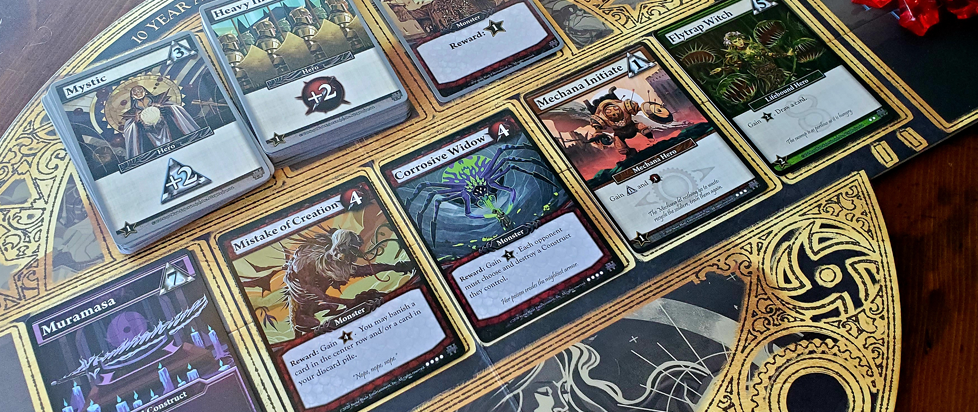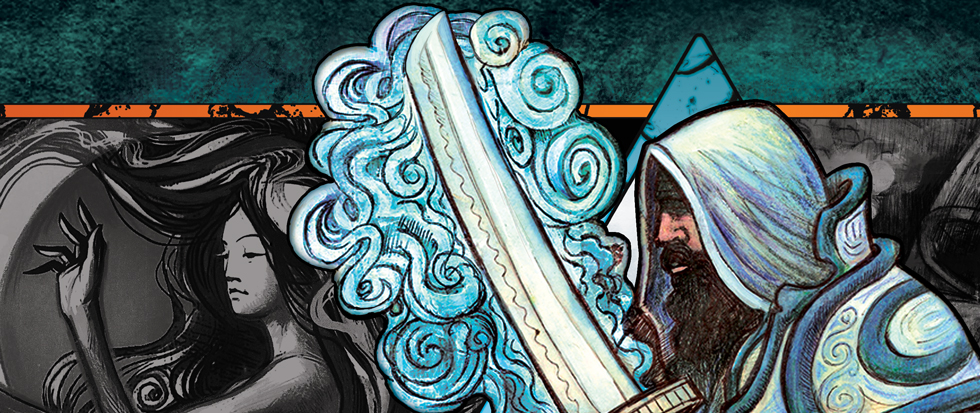
For Honor and Small Plastic Rocks: Ascension’s Place in the Pantheon of Deck-Building Games
I see board games in the store and they always look so cool and then I buy them and bring them home, I’m so excited to open them, and then I play them, like, twice… This column is dedicated to the love of games for those of us whose eyes may be bigger than our stomachs when it comes to playing, and the joy that we can all take from games, even if we don’t play them very often.
In the years since the 1993 release of Magic: The Gathering, deck-building board games have become a huge business. I open with Magic because, even though deck-building games and collectible card games like Magic share few actual mechanics, they share a tightly knit history. Donald X. Vaccarino, who created what many consider to be the first deck-building game, was an avid Magic played who had contributed several fan-made expansions before he launched Dominion.
Released in 2008, Dominion set the standard for deck-builders ever since. It remains a popular title that sees frequent play in my house. In the decade-and-change since its release, however, deck-building games have really taken off, and now there are countless different iterations, themed around all sorts of varied activities.
Which just makes sense. After all, deck-builders are relatively inexpensive to produce and consume, especially compared to many other types of high-concept board games. They’re quick to learn, in part because the specific rules of unique game pieces can just be printed right on them. And they take up relatively little physical space, making them portable and easy to play and store.
Among the slew of deck-building games that have followed in the wake of Dominion, Ascension is one of the biggest players. In fact, the Wikipedia entry for “deck-building game” lists four “notable” examples, besides Dominion: Legendary, Clank!, Thunderstone, and Ascension. Of those, it bears mentioning that three of the four are fantasy themed, perhaps as a result of the form’s ties to Magic: The Gathering, while the fourth is built around superheroes.
First published in 2010, Ascension also traces its origins to Magic: The Gathering. One of the designers – and the head of Stone Blade Entertainment, the studio behind the game – was a professional Magic player, who was a U.S. junior champion at the age of 17. The version of the game I received for review is the recently-released “10 Year Anniversary Edition,” which boasts on the back that it is “Designed by Magic: The Gathering Pro Tour Champions.” The fact that it is a 10-year edition also suggests (correctly) that Ascension has proven popular in the decade since its release.
Fundamentally, the gameplay in Ascension will be familiar to anyone who has ever played Dominion or, really, most any other deck-building game. Indeed, the mechanics of Ascension and Dominion are very similar, with just the names of resources changed.
Players play cards from a hand every turn, and those cards generate resources – either runes or power – which they can then spend to purchase new cards, in the form of heroes or constructs, or fight monsters. The ultimate goal of the game is amassing victory points in the form of honor, represented by small plastic rocks, which can be gotten by defeating monsters, but also through the acquisition of other cards.
The biggest difference between Ascension and Dominion is that, where the cards available to players in Dominion are always the same, Ascension supplements a handful of “always available” cards with cards from a central deck that are dealt out, six at a time, in the center of the play area. These six cards are the ones that are available on a turn, either to purchase or to fight. Once a card is removed from this play area, new cards are revealed to replace them.
There are other minor differences, too. Hero cards stay in play only for the duration of your turn, for example, much like most cards in Dominion, whereas construct cards stay in play from the time you use them, allowing you to tap their special abilities or resources over and over again. However, construct cards can potentially be destroyed by monsters and other players’ abilities.
While ostensibly the goal of the game – as in Dominion – is to acquire more of the victory resource than the other players, Ascension also offers a solo variant that allows you to play against the board, as represented here by the in-game narrative’s Samael, the “Avatara of a fallen God.” When playing in solo mode, Samael essentially devours the two rightmost cards in the play area every turn, acquiring any honor that they would get by doing so.
In this way, gameplay in solitaire mode is considerably simpler than when playing against one or more human players, by dint of the fact that you always know what Samael is going to do. You don’t have to worry about abilities generated by the cards your opponent plays, and you always know which cards are going to go away at the end of your turn. This doesn’t necessarily mean that the tension is dialed down, however.
Knowing full well that the two rightmost cards are about to disappear can lead to some nail-biting decisions, especially when you really want one of those cards, but may not be able to afford it with what you have in your hand. Watching cards that you desperately want slip away into mechanical oblivion can be even more crushing than being outmatched by a human player.
With so many deck-building games on the market, the aesthetic is going to be a big part of what draws a player to one over another. The artwork of Ascension is decidedly in the fantasy vein, and won’t feel out of place to those who come here from Magic: The Gathering, although some effort has been made to ensure that the game’s world of Vigil is at least somewhat internally consistent. There are dragons and the like, to be sure, but more often there are aesthetes and seers and monks, steampunk robots and flytrap witches.
And if you get hooked on Ascension, there are lots of options to keep you spending your money entertained, with more than a dozen expansions, each of which can, ostensibly, be played on its own or combined together with a core set like the 10 Year Anniversary Edition. Stoneblade also launched a successful Kickstarter in 2020 for a new game called Ascension Tactics, which is intended to make use of similar mechanics but also introduce miniatures into a hex-based skirmish game a la Warhammer: Underworlds.
Like a lot of other popular deck-building games, Ascension has also found its way into electronic form, with versions available for IOS, Android, and Steam. I haven’t tried the electronic versions, but it seems like a game that would translate easily from one format to another, just as it’s easy to pick up, play, and – most likely, though I haven’t gotten the chance to try it yet – swap between expansions and editions in the physical game.





